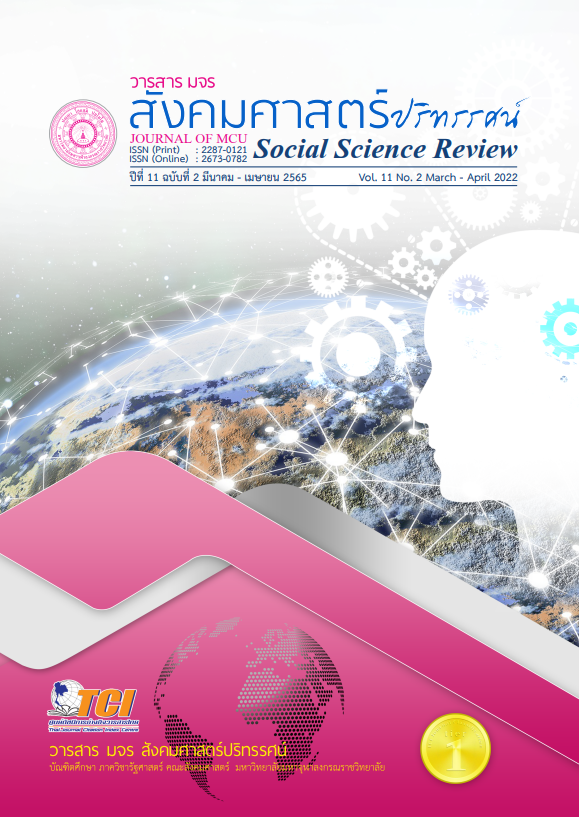การท่องเที่ยวเชิงอาหารพื้นบ้านล้านนา
คำสำคัญ:
การท่องเที่ยวเชิงอาหาร, อาหารพื้นบ้าน, ล้านนาบทคัดย่อ
การท่องเที่ยวเป็นอุตสาหกรรมภาคบริการ ที่สร้างรายได้มหาศาลให้กับระบบเศรษฐกิจอย่างต่อเนื่อง รายได้จากอาหารนับเป็นส่วนหนึ่งของอุตสาหกรรมการท่องเที่ยวเชิงอาหารเป็นการท่องเที่ยวรูปแบบใหม่ที่ช่วยส่งผ่านวัฒนธรรมการกินอาหารพื้นบ้านของแต่ละพื้นที่ไปสู่การท่องเที่ยวอย่างยั่งยืน รวมทั้งเป็นการอนุรักษ์วัฒนธรรมและวิถีชีวิตคนในท้องถิ่นนั้น ๆ ให้คงอยู่ นอกจากนั้นยังมีนักท่องเที่ยวบางกลุ่มที่เลือกสถานที่ท่องเที่ยวจากอาหารพื้นถิ่นอีกด้วย การท่องเที่ยวเชิงอาหารพื้นบ้านล้านนาจะทำให้นักท่องเที่ยวได้ศึกษาเส้นทางของอาหาร ตั้งแต่การหาวัตถุดิบ การผลิต ไปจนถึงการชิมรสชาติอาหาร นอกจากนี้ในจานอาหารหนึ่งจานยังสอดแทรกวิถีชีวิตและวัฒนธรรม ตลอดจนการนำเอาตำหรับอาหารที่สืบทอดมาปรับปรุงและพัฒนาโดยการประยุกต์เมนูอาหารล้านนาแบบดั่งเดิมร่วมกับนวัตกรรมที่ทันสมัย มารังสรรค์จนเกิดเป็นเมนูอาหารที่มีการจัดองค์ประกอบในจานอาหารด้วยความประณีตสวยงามแต่ยังคงไว้ซึ่งรสชาติแบบดั่งเดิม โดยมุ่งศึกษาถึงแนวคิดการท่องเที่ยวเชิงอาหาร อาหารพื้นบ้านล้านนา ประเภทของอาหารพื้นบ้านล้านนา รูปแบบการท่องเที่ยวเชิงอาหารพื้นบ้านล้านนา อาหารพื้นบ้านล้านนาที่ได้รับความนิยมจากนักท่องเที่ยว การพัฒนานวัตกรรมอาหารพื้นบ้านล้านนาให้มีความทันสมัยมากขึ้น เพื่อนำมาเป็นจุดขายและสร้างมูลค่าเพิ่มในการพัฒนาการท่องเที่ยว ซึ่งจะส่งผลดีต่อเศรฐกิจ การพัฒนาคุณภาพชีวิตให้แก่คนในท้องถิ่นอันจะนำไปสู่ความยั่งยืนของอาหารพื้นบ้านล้านนาต่อไป
เอกสารอ้างอิง
กนกกานต์ วีระกุล และคณะ. (2556). การท่องเที่ยวเพื่อการเรียนรู้เกี่ยวกับอาหาร. กรุงเทพฯ: มหาวิทยาลัยราชภัฏสวนดุสิต.
กระทรวงการท่องเที่ยวและกีฬา กองเศรษฐกิจการท่องเที่ยวและกีฬา. (2564). รายงานภาวะเศรษฐกิจการท่องเที่ยว, Tourism Economic, 2(1), 5.
การท่องเที่ยวแห่งประเทศไทย. (ม.ป.ป.). มาตรฐานความปลอดภัยด้านสุขอนามัย Amazing Thailand Safety & Health Administration (SHA). สืบค้น 18 กรกฎาคม 2564, จาก https://www.thailandsha.com/index#Infomation
ทัศนีย์ อารมณ์เกลี้ยง และสุภาพ ฉัตราภรณ์. (2557). เส้นทางการสืบสานภูมิปัญญาอาหารล้านนาสู่ความยั่งยืน. วารสาร เกษตรศาสตร์ (สังคม), 35(2), 189-205.
นันทิยา ตันตราสืบ และวารัชต์ มัธยมบุรุษ. (2561). การศึกษาเรื่องพฤติกรรมการบริโภคอาหารพื้นถิ่นล้านนาของนักท่องเที่ยวชาวต่างชาติในจังหวัดเชียงใหม่. วารสาร สังคมศาสตร์วิชาการ, 11(1), 97-106.
พัชรี ตั้งตระกูล และคณะ. (2557). การสร้างคุณค่าอาหารไทยท้องถิ่นเพื่อสนับสนุนการท่องเที่ยวภาคเหนือ (รายงานผลการวิจัย). กรุงเทพฯ: สถาบันค้นคว้าและพัฒนาผลิตภัณฑ์อาหาร มหาวิทยาลัยเกษตรศาสตร์.
มิ่งสรรพ์ ขาวสอาด. (2563). Tourism Economic Review : ทิศทางท่องเที่ยวไทยหลังวิกฤตโควิด-19. วารสาร รายงานภาวะเศรษฐกิจการท่องเที่ยว, 1(4), 42-53.
มหาวิทยาลัยเชียงใหม่ ศูนย์นวัตกรรมอาหารและบรรจุภัณฑ์. (ม.ป.ป.). Gastronomy Tourism : Lanna Gastronomy. สืบค้น 4 กันยายน 2564, จากhttps://sdgs.cmu.ac.th/en/ArticleDetail/a08754eb-b060-45d4-ae07-12aff947c002
มหาวิทยาลัยเชียงใหม่ สำนักหอสมุด ศูนย์สารสนเทศภาคเหนือ. (ม.ป.ป.). อาหารพื้นบ้านล้านนา. สืบค้น 19 กรกฎาคม 2564, จาก http://lannainfo.library.cmu.ac.th /lannafood/classify_food.php
มหาวิทยาลัยเชียงใหม่ สำนักหอสมุด ศูนย์สารสนเทศภาคเหนือ. (ม.ป.ป.). การจัดสำรับขันโตกเพื่อเลี้ยงแขก และขันโตกดินเนอร์. สืบค้น 5 กันยายน 2564, จาก http://lannainfo.library.cmu.ac.th/lannafood/culture_lanna3.php
มหาวิทยาลัยเชียงใหม่. (2563). ถอดรหัสอาหารล้านนาให้ “ล้ำ” และ “ลำ” ด้วยนวัตกรรมอาหาร. สืบค้น 5 กันยายน 2564, จาก https://sdgs.cmu.ac.th /th/ArticleDetail/a08754eb-b060-45d4-ae07-12aff947c002
รัตนา พรหมพิชัย. (2542). สารานุกรมวัฒนธรรมไทย ภาคเหนือ. กรุงเทพฯ: มูลนิธิสารานุกรมวัฒนธรรมไทย ธนาคารไทยพาณิชย์.
สรัสวดี อ๋องสกุล. (2561). ประวัติศาสตร์ล้านนา ฉบับสมบูรณ์ (พิมพ์ครั้งที่ 12). กรุงเทพฯ: สำนักพิมพ์อมรินทร์.
สำนักงานปลัดกระทรวงการท่องเที่ยวและกีฬา. (2560). แผนพัฒนาการท่องเที่ยวแห่งชาติ ฉบับที่ 2 พ.ศ. 2560-2564. กรุงเทพฯ: โรงพิมพ์องค์การสงเคราะห์ทหารผ่านศึก.
สำนักงานพัฒนาเศรษฐกิจจากฐานชีวภาพ (องค์การมหาชน). (2552). สารานุกรมภูมิปัญญาอาหารท้องถิ่นไทย 4 ภาค. กรุงเทพฯ: สำนักงานพัฒนาเศรษฐกิจจากฐานชีวภาพ (องค์การมหาชน).
เสมอพร สังวาสี. (2549). อาหารไทยสี่ภาค. กรุงเทพฯ: Health & Cuisine.
องค์การบริหารการพัฒนาพื้นที่พิเศษเพื่อการท่องเที่ยวอย่างยั่งยืน (องค์การมหาชน). (2559). GASTRONOMY TOURISM ท่องเที่ยวเชิงอาหาร. กรุงเทพฯ: โคคูน แอนด์ โค จำกัด.
Cohen, E. & Avieli, N. (2004). Food in tourism. Annals of tourism research, 3(1): 755-778.
Du Rand, G. E.& Heath, E. (2006). Current Issues in Tourism, Towards a Framework for Food Tourism as an Element of Destination Marketing. Journal of Travel and Tourism Marketing, 9(3), 206-234.
GO2ASKANNE. (ม.ป.ป.). อยู่ดีกินหวาน...ที่ชุมชนลวงเหนือ. สืบค้น 4 กันยายน 2564, จาก https://www.go2askanne.co/ชุมชนลวงเหนือ/
Michelin Guide. (2019). 10 อาหารเหนือที่คุณห้ามพลาด. สืบค้น 19 กรกฎาคม 2564, จากhttps://guide.michelin.com/th/th/article/features/10-northern-thai-dishes-you-should-know
UNWTO. (2020). World Tourism Barometer: การจัดลำดับประเทศที่มีรายได้จากการท่องเที่ยวสูงสุด 10 อันดับแรกในปี 2018. สืบค้น 18 กรกฎาคม 2564, จาก https://www.e-unwto.org/doi/epdf/10.18111/wtobarometereng .2020. 18.1.7
ดาวน์โหลด
เผยแพร่แล้ว
รูปแบบการอ้างอิง
ฉบับ
ประเภทบทความ
สัญญาอนุญาต
ลิขสิทธิ์ (c) 2022 วารสาร มจร สังคมศาสตร์ปริทรรศน์

อนุญาตภายใต้เงื่อนไข Creative Commons Attribution-NonCommercial-NoDerivatives 4.0 International License.
เพื่อให้เป็นไปตามกฎหมายลิขสิทธิ์ ผู้นิพนธ์ทุกท่านต้องลงลายมือชื่อในแบบฟอร์มใบมอบลิขสิทธิ์บทความให้แก่วารสารฯ พร้อมกับบทความต้นฉบับที่ได้แก้ไขครั้งสุดท้าย นอกจากนี้ ผู้นิพนธ์ทุกท่านต้องยืนยันว่าบทความต้นฉบับที่ส่งมาตีพิมพ์นั้น ได้ส่งมาตีพิมพ์เฉพาะในวารสาร มจร สังคมศาสตร์ปริทรรศน์ เพียงแห่งเดียวเท่านั้น หากมีการใช้ภาพหรือตารางหรือเนื้อหาอื่นๆ ของผู้นิพนธ์อื่นที่ปรากฏในสิ่งตีพิมพ์อื่นมาแล้ว ผู้นิพนธ์ต้องขออนุญาตเจ้าของลิขสิทธิ์ก่อน พร้อมทั้งแสดงหนังสือที่ได้รับการยินยอมต่อบรรณาธิการ ก่อนที่บทความจะได้รับการตีพิมพ์ หากไม่เป็นไปตามข้อกำหนดเบื้องต้น ทางวารสารจะถอดบทความของท่านออกโดยไม่มีข้อยกเว้นใดๆ ทั้งสิ้น





